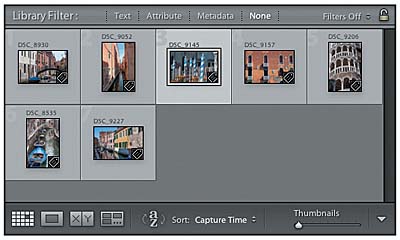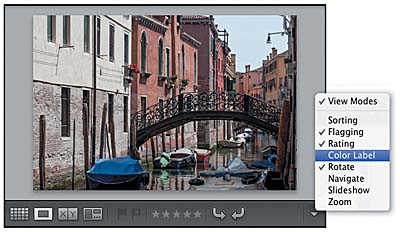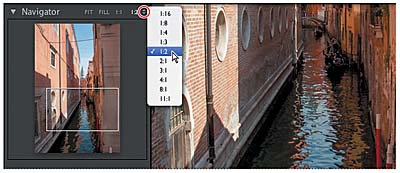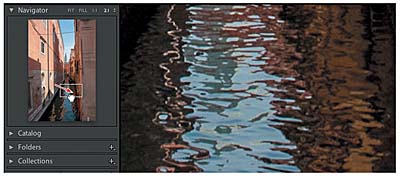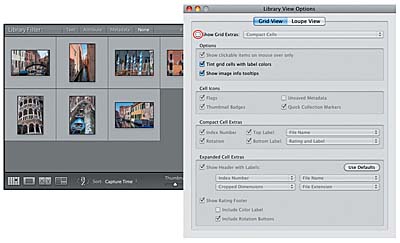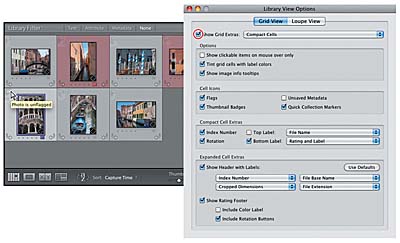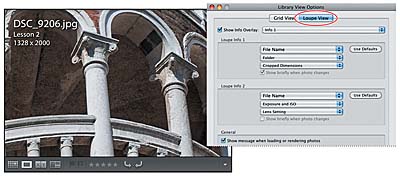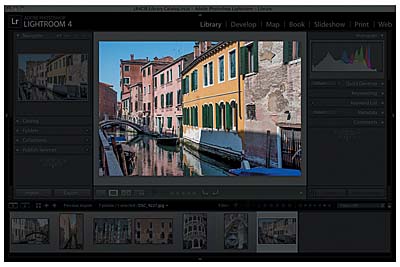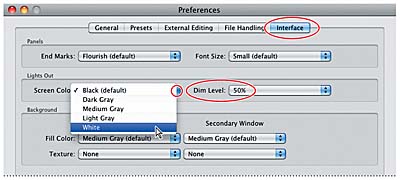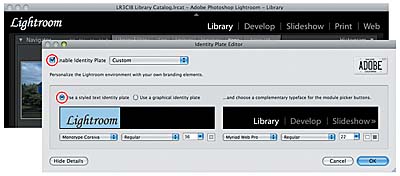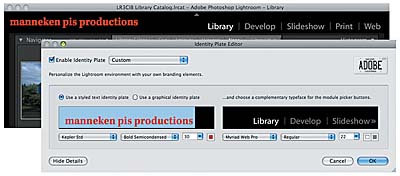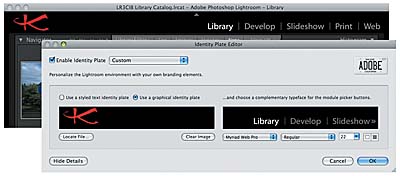- 2. Introducing the Workspace
- Toggling screen modes
- Adjusting the workspace layout
- Working with the left and right panel groups
- Working with the main display area
Working with the main display area
The main display area—the work area—in the center of the application window is where you select, sort, and compare the images in your library, and preview the work in process as you make adjustments and create presentations. The work area serves different purposes in each of the Lightroom workspace modules. The Library and Develop modules offer a choice of view modes to suit a range of tasks, from organizing and sharing your collections to editing the individual photos. In the Slideshow, Print, and Web modules, the work area presents a working preview of your projects and presentations.
View modes
Depending on your workspace setup in the Library module, you may see the Filter bar across the top of the work area. You can use filters to limit the photos that are displayed in the Grid view and the Filmstrip to those that have been assigned a specified rating or flag status, or contain particular metadata content. You’ll learn more about using the Filter bar controls in Lesson 5, “Organizing and Selecting.”
Across the bottom of the work area is the Toolbar. The Toolbar is common to all the workspace modules but contains different tools and controls for each.
- If you’re not already in the Library module, switch to it now.
- If the Filter bar is not already visible at the top of the work area, show it by pressing the backslash character (\) on your keyboard or by activating the menu option View > Show Filter Bar. Press backslash again or disable the menu option View > Show Filter Bar to hide it.
- If the Toolbar is not already visible, press T to show it. Press T again to hide it.
- Switch to the Develop module. If the Toolbar is not already visible, press T to show it. Switch back to the Library Module. In the Library module the Toolbar is still hidden from step 3; Lightroom remembers your Toolbar setting for each module independently. Press T to show the Toolbar in the Library module.
- Double-click an image in Grid view to switch to Loupe view. The Loupe view is available in both the Library and Develop modules, but the controls available in the Loupe view Toolbar differ for each of these modules.
- You can hide or show individual tools by choosing their names from the menu at the right end of the Toolbar. Tools that are currently visible in the Toolbar have a checkmark in front of their names.
- Click Fit in the zoom controls in the top right corner of the Navigator panel. Now click the 1:1 control. Choose View > Toggle Zoom View, or press Z. The zoom setting reverts to Fit. Press the Z key; the zoom setting reverts to 1:1.
- Click Fill in the zoom controls in the top right corner of the Navigator panel. Now choose a zoom ratio from the menu at the far right of the Navigator panel header; we used 2:1. Click the image in the Loupe view. The zoom setting reverts to Fill. In Loupe view, clicking the image is equivalent to pressing the Z key, or choosing View > Toggle Zoom View, except that the zoomed view of the image will be centered on the area you clicked.
- While the view is magnified, drag the zoom rectangle in the Navigator preview, or drag in the Loupe view to change the area currently visible in the work area. At higher zoom levels you may find using the Navigator panel more convenient; dragging in the Loupe view is better suited to working at lower zoom levels.
- Press the Home key, or fn+Left Arrow, to position the zoom rectangle in the top left corner of the image; then press the Page Down key (fn+Down Arrow) repeatedly to scroll through the magnified image one section at a time. When you reach the bottom of the image the zoom rectangle jumps to the top of the next column. To start in the lower right corner of the image, press the End key (fn+Right Arrow); then use the Page Up key (fn+Up Arrow). This feature can be very helpful when you wish to inspect the entire image in close detail.
In Loupe view, you can view your images at different levels of magnification. The zoom controls in the top right corner of the Navigator panel in the left panel group enable you to switch quickly between preset magnification levels. You can choose from Fit, Fill, 1:1, or choose another option from a menu of ten zoom ratios.
You can toggle between zoom levels by choosing View > Toggle Zoom View, or pressing Z on your keyboard. To better understand the Toggle Zoom View command, you should be aware that the magnification controls in the Navigator panel are organized into two groups: Fit and Fill are in one group, and the zoom ratio settings are in the other. The Toggle Zoom View command toggles between the magnification levels last used in each group.
The zoom controls and the Navigator panel work the same way for the Loupe view in both the Library and Develop modules.
The other two view modes, Compare view and Survey view, will be covered in Lesson 4, “Reviewing,” and Lesson 6, “Developing and Editing.”
Grid and Loupe view options
You can customize the information Lightroom displays for each image in the Grid and Loupe views. Choose your preferences from the many options in the Library View Options dialog box. For Loupe view and the thumbnail tooltips you can activate two sets of options, and then use a keyboard shortcut to switch between them.
- Press G to switch to Grid view in the Library module.
- Choose View > View Options. The Library View Options dialog box will appear with the Grid View tab already selected. Position the Library View Options dialog box so you can see some of the images in the Grid view.
- Disable the Show Grid Extras option in the top left corner of the Grid View tab. This will disable most of the other options.
- The only options still available are Tint Grid Cells With Label Colors and Show Image Info Tooltips. If they are not already activated, click the checkboxes for both of these options. As the images have not yet been assigned color labels, activating the first option has no visible effect in the Grid view. Right-click / Control-click any thumbnail in the Grid view—you can do this while the Library View Options dialog box is open—and choose a color from the Set Color Label menu. A color-labeled image that is currently selected will show a thin colored frame around the thumbnail; a color-labeled image that is not selected has a tinted cell background.
- Position the pointer over a thumbnail in the Grid view or the Filmstrip; a tooltip appears. In Mac OS you’ll need to click anywhere in the Lightroom workspace window to bring it to the front before you can see the tooltips. By default, the tooltip will display the file name, capture date and time, and the cropped dimensions. You can specify the information to be displayed in the tooltip by choosing from the Loupe View options.
- On Mac OS, if the Library View Options dialog box is now hidden behind the main application window, press Command+J to bring it back to the front.
- Activate the Show Grid Extras option and choose Compact Cells from the menu beside it. Experiment with each setting to see its effect in the Grid view display. Activate and disable the settings for Options, Cell Icons, and Compact Cell Extras. Position the pointer over the various icons in the image cells to see tooltips with additional information.
- Under Compact Cell Extras, click the Top Label menu to see the long list of choices available. For some choices, such as Title or Caption, nothing will be displayed until you add the relevant information to the image’s metadata.
- Now choose Expanded Cells from the Show Grid Extras menu. Experiment with the options under Expanded Cell Extras to see the effects in the Grid view. Click any of the Show Header With Labels menus to see the many choices available to customize the information that is displayed in the cell headers.
- Click the Loupe View tab. The work area switches from Grid to Loupe view so you can preview the effects of the changes you’ll make in the Library View Options dialog box.
- Click
the Close button (x) / (
 )
to close the Library View Options
dialog box.
)
to close the Library View Options
dialog box. - You can choose which of the two information sets will be displayed by choosing an option from the View > Loupe Info menu, or by pressing the I key to cycle the info overlay through Loupe Info 1, Loupe Info 2, and its disabled state.
- Switch to the Grid view. From the View > Grid View Style menu you can choose whether or not to display additional information, using either the Compact Cells layout or the Expanded Cells layout. Press the J key to cycle through the Compact Cells layout, with and without additional information, and the Expanded Cells layout.
For the Loupe view, you can activate the Show Info Overlay option to display image information in the top left corner of the view. Choose items from the menus in Loupe Info 1 and Loupe Info 2 to create two different sets of information, and then choose either set from the Show Info Overlay menu. When you choose an information item such as Capture Date And Time, Lightroom extracts those details from the image metadata. If the image’s metadata does not contain the specified information, nothing will be displayed for that item. For both the Grid and Loupe view options you can choose the information item Common Attributes, which will display the flagged status, star rating and color label for each image.
You can reset either group to its default state by clicking the Use Defaults button. Activate the Show Briefly When Photo Changes option to show the info overlay for only a few seconds when a new image is displayed in the Loupe view. Activate the Show Message When Loading Or Rendering Photos option to display a notification in the lower part of the view while the image preview is updated. It is recommended that you keep this option activated so that you don’t inadvertently make judgments about the quality of an image before the update is complete.
Dimming lights
Lightroom gives you the option to darken the workspace so that you can focus on the image or images with which you’re working. In the Library and Develop modules, everything is dimmed or darkened except your selected photos. In the other three modules, everything except the presentation preview in the work area is dimmed or darkened. All tools and controls will still work in the Lights Dim or Lights Off modes—if you can find them! You could pick up the crop tool for example, and then switch to either the Lights Dim or Lights Off mode to help you concentrate on achieving the best result.
- To dim the lights, press the L key or choose Window > Lights Out > Lights Dim.
- If you’re in the Grid view, double-click an image to switch to Loupe view. Click the image to switch between zoom levels. If you can see the Filmstrip, click to select a different image. Switch to a different module. If you remember the keyboard shortcuts they can really come in handy now.
- To darken the workspace around the image completely, press the L key again or choose Window > Lights Out > Lights Off—if you can still see the menu bar. To return to the normal display mode, press the L key a third time, or choose Window > Lights Out > Lights On.
- To change the Lights Out screen color or to adjust the opacity for the Lights Dim mode, choose Edit > Preferences / Lightroom > Preferences. In the Preferences dialog box, click the Interface tab and choose a new opacity value from the Dim Level menu in the Lights Out options. From the Screen Color menu, choose white or a shade of grey.
- Click
OK / the Close button (
 )
to close the Preferences dialog
box, and press the L key repeatedly
to see your new settings in
effect. Return to step 4 to
modify your settings or reinstate
the defaults.
)
to close the Preferences dialog
box, and press the L key repeatedly
to see your new settings in
effect. Return to step 4 to
modify your settings or reinstate
the defaults.
Lightroom achieves the dimming and darkening effects by means of a black overlay applied to the interface—at a default opacity of 80% for Lights Dim and 100% for Lights Off. You can choose instead to have the workspace fade to white or a shade of grey. This might be useful, for example, if your images contain a lot of black or dark colors. You can also adjust the level of opacity for the Lights Dim mode so that you can still see the controls if necessary.
Personalizing the identity plate
If you’re using Lightroom to make presentations to clients on your computer, or if you’d simply like to personalize the workspace, you can change the graphic that is displayed as an identity plate in the top panel.
- If the top panel is not currently visible, press the F5 key on your keyboard, or choose Window > Panels > Show Module Picker.
- Choose Edit > Identity Plate Setup / Lightroom > Identity Plate Setup. Position the Identity Plate Editor dialog box so you can see both the dialog box and the identity plate in the top panel.
- If not already selected, activate the Use A Styled Text Identity Plate option. Then activate the Enable Identity Plate option. You’ll notice an immediate change in the appearance of the identity plate.
- Select the text in the text box and replace it with your own.
- Press Ctrl+A / Command+A to select your new text, and choose a typeface, font style, and font size from the menus beneath the text box. Use your company’s corporate typeface or your own favorite—not necessarily mutually exclusive choices. Click the color box beside the font size menu and choose a new color from the Colors palette. Keep an eye on how your choices look in the top panel. Click OK to apply your changes or Cancel to reject them.
- (Optional) You can also change the typeface, font style, and font size used for the text in the Module Picker to better suit your new identity plate design. There is a second set of controls in the Identity Plate Editor dialog box for this purpose. Click the first color box to change the color used to highlight the name of the active module and the second to change the color used for the others.
- To use an image as your identity plate, Choose Edit > Identity Plate Setup / Lightroom > Identity Plate Setup. In the Identity Plate Editor dialog box, activate the Use A Graphical Identity Plate option, and then click Locate File. In the Locate File dialog box, navigate to your Lesson 2 folder, select the file Identityplate.png, and click Choose.
- (Optional) You can save several identity plate setups as presets that can be easily accessed for different situations. Choose Save As from the Enable Identity Plate menu, enter a name for your identity plate preset and click Save. Your identity plate presets will appear in the Enable Identity Plate menu.
- Disable the Enable Identity Plate option, and then click OK to close the Identity Plate Editor dialog box.
To personalize the identity plate, you can either use styled text or place a graphic of your choice. If you wish, you can also change the typeface and text color used for the Module Picker at the other end of the top panel to better suit your design.
